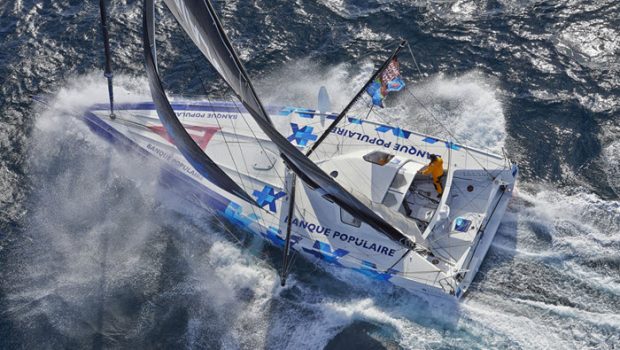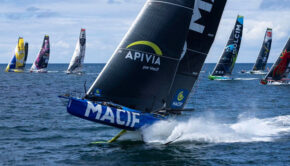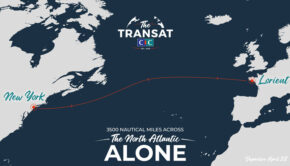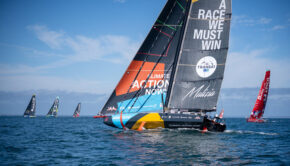Preparing for the Grind of Solo Racing
Published on September 19th, 2018
The physical and mental profile of the solo racers has changed massively, and in order to have a chance of winning, of sustaining a very high level of performance for days on end, the IMOCA skipper now is a highly trained athlete.
Dr. Laure Jacolot has witnessed this change, working closely with the Pole Finistère which is the most successful training group with an unmatched record for producing Vendée Globe winning skippers over the last four editions.
As a sports medicine professional, her involvement with the skippers of this 60-foot rocket ship solidifies the credo that ‘prevention is better than cure’. In terms of preparation for the Vendée Globe, held every four years, she stresses that you can never start on the physical preparation too early.
The physical trainers and sports medics who look after their preparation and planning are like engineers designing and fine tuning a machine. In this interview, Jacolot details her approach:
You emphasize the ongoing importance of long terms physical preparation?
Indeed. The more we do earlier in the phase then the more we can do in reducing the risk of some kind of trauma. We have seen a relationship between physical characteristics and profiles and see them linked to some traumas. Typically we might see acute tendonitis or strains as consequence of insufficient early training.
You have to remember there are two aspects to the preparation, so muscular strength and power, and aerobic or cardio power and endurance. That works need to begin as early as possible and be tailored to the morphology of the sailor and to his or her boat.
So it is a very personalized, tailored work?
Exactly. We will try to take into account all the parameters that make up the profile of the competitors. First there is the morphology (height and shape) of each and their inherent physical qualities. And we then tack into account the boat and its ergonomics, check if the boat is adapted to racing efficiently solo. Being able to observe the sailors on board is often instructive.
In real terms then how and what do you monitor?
First of all, we have a whole selection of tests that will allow us to make a precise cardiovascular evaluation. This work is completed by an assessment of the morpho-skeletal potential of each sailor. Then, before setting up a preparation plan, we spend time with the sailors to better know their tastes, that is to say what they actually like to do. And so if you want to deliver an effective physical and medical preparation, you cannot ignore what they like and what they don’t like.
Skippers report how the foiling IMOCA is more physical. How has this affected what you do?
It is clear that the movements are more and more brutal. Some sailors start to equip themselves with helmets when they are inside the cabin. There are also plans to equip some with some kind of chest protection. Several sailors have broken ribs: on the one hand, it is extremely painful and disabling and on the other hand, there can be dramatic consequences if unfortunately a rib pierces the lung.
Currently, we are beginning to teach them about some extreme trauma situations such as war injuries and that helps in a way to prevent dramatic accidents. Such things are not pleasant to for skippers to hear, but I think it is necessary that they are fully aware of the risks they take. Then there are choices to make.
Today, a government directive advocates the exclusion of morphine from medical kits, as it is considered a narcotic by the customs authorities of some countries. Personally, in view of the accidents that I observed such as those of Yann Eliès on the Vendée Globe 2008 or Paul Meilhat on the Transat between St. Barts and Brittany, I will continue to prescribe morphine in first aid kits.
And of course now a new parameter prevails today with the introduction of foils. Their use generates an incredible noise. Until now there has been no degradation of the hearing of sailors, but the continued racket is very uncomfortable and a source of fatigue and additional stress. Recovery becomes more difficult. And so this is one of our areas of work for the next two years. ”
Are there other areas of prevention that sailors might tend to neglect?
Personally, I emphasize three points that seem to me fundamental. The first is to ensure a good diet, to facilitate the best possible digestion. Diet is so linked to good health and to performance, but still this is neglected by some. Of course, you have to have a thorough dental check-up before you leave. Again, it must be done super early, some treatments can be long. We must never forget that stress and poor hydration can “wake up” illnesses or conditions which might otherwise have remained dormant. Finally, it is essential to consult with a dermatologist. Some people are more sensitive than others to skin blisters and rashes and must be very careful before starting before the start, it is extremely hard to manage hard sails when hands are affected by infected blisters.









 We’ll keep your information safe.
We’ll keep your information safe.